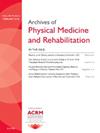Evaluating the Effectiveness of Transtibial Prosthetic Socket Shape Design Using Artificial Intelligence: A Clinical Comparison With Traditional Plaster Cast Socket Designs
IF 3.6
2区 医学
Q1 REHABILITATION
Archives of physical medicine and rehabilitation
Pub Date : 2025-02-01
DOI:10.1016/j.apmr.2024.08.026
引用次数: 0
Abstract
Objective
To investigate the feasibility of creating an artificial intelligence (AI) algorithm to enhance prosthetic socket shapes for transtibial prostheses, aiming for a less operator-dependent, standardized approach.
Design
The study comprised 2 phases: first, developing an AI algorithm in a cross-sectional study to predict prosthetic socket shapes. Second, testing the AI-predicted digitally measured and standardized designed (DMSD) prosthetic socket against a manually measured and designed (MMD) prosthetic socket in a 2-week within-subject cross-sectional study.
Setting
The study was done at the rehabilitation department of the Radboud University Medical Center in Nijmegen, the Netherlands.
Participants
The AI algorithm was developed using retrospective data from 116 patients from a Dutch orthopedic company, OIM Orthopedie, and tested on 10 randomly selected participants from Papenburg Orthopedie.
Interventions
Utilization of an AI algorithm to enhance the shape of a transtibial prosthetic socket.
Main Outcome Measures
The algorithm was optimized to minimize the error in the test set. Participants’ socket comfort score and fitting ratings from an independent physiotherapist and prosthetist were collected.
Results
Predicted prosthetic shapes deviated by 2.51 mm from the actual designs. In total, 8 of 10 DMSD and all 10 MMD-prosthetic sockets were satisfactory for home testing. Participants rated DMSD-prosthetic sockets at 7.1 ± 2.2 (n=8) and MMD-prosthetic sockets at 6.6 ± 1.2 (n=10) on average.
Conclusions
The study demonstrates promising results for using an AI algorithm in prosthetic socket design, but long-term effectiveness and refinement for improved comfort and fit in more deviant cases are necessary.
利用人工智能评估胫骨假体插座形状设计的有效性:与传统石膏支架设计的临床比较。
研究目的本研究探讨了创建一种人工智能算法来增强经胫假肢的假肢套筒形状的可行性,旨在减少对操作者的依赖,实现标准化方法:研究分为两个阶段:首先,在横断面研究中开发一种人工智能算法,以预测义肢套筒的形状。其次,在为期两周的受试者横断面研究中,将人工智能预测的数字化测量和标准化设计(DMSD)义肢窝与人工测量和设计(MMD)义肢窝进行对比测试:研究地点:荷兰奈梅亨拉德布德大学医学中心康复科:人工智能算法是利用荷兰一家骨科公司 116 名患者的回顾性数据开发的:干预措施:干预措施:利用人工智能算法改善经胫假肢插座的形状:对算法进行了优化,以尽量减少测试集中的误差。收集了参与者的义肢套筒舒适度评分(SCS)以及来自独立理疗师和义肢师的安装评分:结果:预测的假肢形状与实际设计偏差为 2.51 毫米。8/10个DMSD假体套筒和所有10个MMD假体套筒在家庭测试中均令人满意。参与者对DMSD义肢套筒的平均评分为7.1 ± 2.2(n=8),对MMD义肢套筒的平均评分为6.6 ± 1.2(n=10):这项研究表明,人工智能算法在义肢套筒设计中的应用前景广阔,但仍需对其进行长期有效的改进,以提高更多偏差病例的舒适度和贴合度。
本文章由计算机程序翻译,如有差异,请以英文原文为准。
求助全文
约1分钟内获得全文
求助全文
来源期刊
CiteScore
6.20
自引率
4.70%
发文量
495
审稿时长
38 days
期刊介绍:
The Archives of Physical Medicine and Rehabilitation publishes original, peer-reviewed research and clinical reports on important trends and developments in physical medicine and rehabilitation and related fields. This international journal brings researchers and clinicians authoritative information on the therapeutic utilization of physical, behavioral and pharmaceutical agents in providing comprehensive care for individuals with chronic illness and disabilities.
Archives began publication in 1920, publishes monthly, and is the official journal of the American Congress of Rehabilitation Medicine. Its papers are cited more often than any other rehabilitation journal.

 求助内容:
求助内容: 应助结果提醒方式:
应助结果提醒方式:


